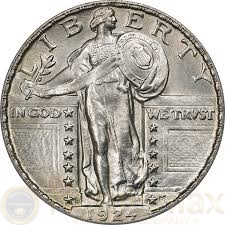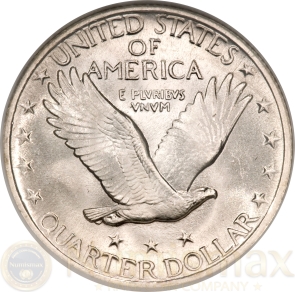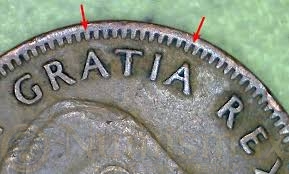 Heads or tails, the anatomy of The Faces of a coin are essentially the same. Before we get into the details, let’s first take a look at the journey the image takes getting from the artist’s mind to the face of the coin.
Heads or tails, the anatomy of The Faces of a coin are essentially the same. Before we get into the details, let’s first take a look at the journey the image takes getting from the artist’s mind to the face of the coin.
Whether it’s a star, a face, or an eagle, each individual image on a coin is known as a device. Most people don’t realize this, but when a coin is engraved by an artist, all of the devices are engraved onto a disc that often has a diameter 10 to 12 times larger than than that of the final coin. Working in a larger scale allows the artist to create the incredible detail that most coins have. That detail is not just beautiful to look at, but also makes it harder for someone to counterfeit. The large disc is placed on a machine called a radial pantograph. Think of how a key is copied from a host key. This is quite similar except that both discs are spinning like on a record player, and gears are used to reduce the image to the desired size. Now that we know the general idea about how those images get onto the coin, let’s look at them individually.
 Typically, the device in the middle of the obverse of a US coin, the faces, is the image of Lady Liberty, or the profile of a past president. As an effort to separate the democracy of the United States from the monarchies of Europe, our founding fathers made a law that no sitting president shall have their image on a coin. As a matter of fact, it took the US mint 117 years to put the faces of a past president on a coin with Abraham Lincoln being added to the One Cent coin in 1909. The central image on the reverse of a US coin is typically an eagle, but there are many exceptions to this rule. For US coins, the date, mint mark, denomination, and United Sates of America are all required elements. Whether they are on the obverse or reverse are up to artistic interpretation. Why are these all important? The country and denomination are required to make them legal tender in the United States. The date and the mint mark are also required for this purpose, but are further required to aid the treasury when filling production quotas for a particular year, and also for pulling coins from circulation. This happens for a number of reasons, but two of the biggest recalls came in 1914 to help with aiding WWI efforts, and in 1965 after the US abandoned the silver standard, and bought back silver coins from the public. The motto “In God We Trust” is common place of US coins now, but hasn’t always been. First appearing on the two cent piece in 1864, this motto has made sporadic appearances on coins until 1908 where it has appeared consistently since.
Typically, the device in the middle of the obverse of a US coin, the faces, is the image of Lady Liberty, or the profile of a past president. As an effort to separate the democracy of the United States from the monarchies of Europe, our founding fathers made a law that no sitting president shall have their image on a coin. As a matter of fact, it took the US mint 117 years to put the faces of a past president on a coin with Abraham Lincoln being added to the One Cent coin in 1909. The central image on the reverse of a US coin is typically an eagle, but there are many exceptions to this rule. For US coins, the date, mint mark, denomination, and United Sates of America are all required elements. Whether they are on the obverse or reverse are up to artistic interpretation. Why are these all important? The country and denomination are required to make them legal tender in the United States. The date and the mint mark are also required for this purpose, but are further required to aid the treasury when filling production quotas for a particular year, and also for pulling coins from circulation. This happens for a number of reasons, but two of the biggest recalls came in 1914 to help with aiding WWI efforts, and in 1965 after the US abandoned the silver standard, and bought back silver coins from the public. The motto “In God We Trust” is common place of US coins now, but hasn’t always been. First appearing on the two cent piece in 1864, this motto has made sporadic appearances on coins until 1908 where it has appeared consistently since.
The areas between the devices are known as the fields. Typically completely flat, the fields are important areas in determining the condition of a coin. The luster of a business struck coin will wear off of the coin’s fields rather early during its life in circulation, thus being a good indicator of the variances in the higher circulated grades.
 Last but not least, is the rim. These can come in many forms, but on US coins are usually either plain, like on a nickel, or with small rectangular protrusions called denticles. The $2.50 and $5 Indians are the exception to this rule. They each have an incuse design, meaning that the the devices are carved into the fields, as opposed to seemingly resting on top of them, and have no rims. For some issues, the dies did not align properly, and a partial wire rim is visible. This is one of the key diagnostics in determining the a real 1911 D $2.50 Indian, which is the key date of that series.
Last but not least, is the rim. These can come in many forms, but on US coins are usually either plain, like on a nickel, or with small rectangular protrusions called denticles. The $2.50 and $5 Indians are the exception to this rule. They each have an incuse design, meaning that the the devices are carved into the fields, as opposed to seemingly resting on top of them, and have no rims. For some issues, the dies did not align properly, and a partial wire rim is visible. This is one of the key diagnostics in determining the a real 1911 D $2.50 Indian, which is the key date of that series.
Thanks for reading The Faces installment of this series on coin anatomy. In the next installment, we will discuss alloy and strike.


